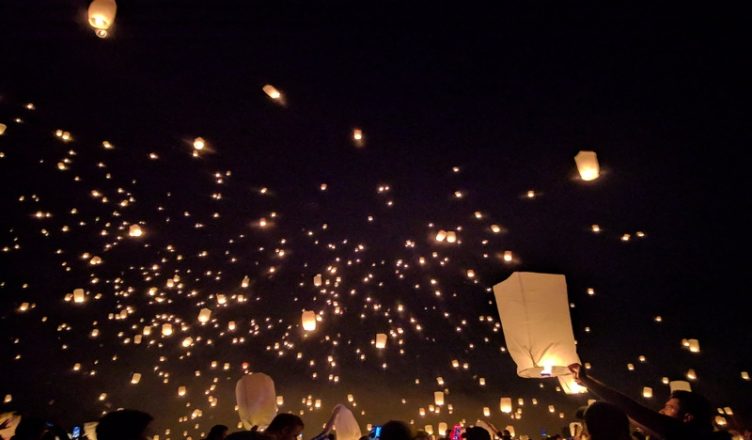Thailand is a soulful place in Southeast Asia. This tropical country has sacred temples, serene beaches, and captivating landscapes. Thai people celebrate various festivals that hold cultural and historical significance — and also attract tourists from around the world.
The most popular Thai festivals are the Loy Krathong Lantern Festival and the Yi Peng Lantern Festival. In both these festivals, the visual aesthetics are very romanticizing. In the Yi Peng festival, lanterns made of bamboo and fuel cells are released into the air. It is mostly celebrated in Northern Thailand and Chiang Mai. The Loy Krathong festival is however more popular than the Yi Peng festival and is celebrated all over Thailand. Following is a brief description of this magnificent festival of lights, the Loy Krathong festival.
Legend of the Festival
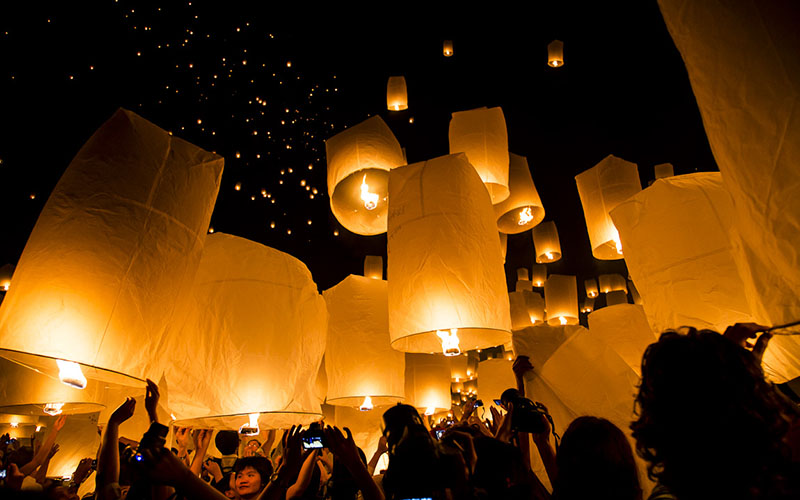
The history behind this festival dates back to 800 years ago during the reign of King Ram Kamphaeng. The King and the royal family were on an exotic cruise trip to celebrate the lantern festival on the 12th full moon night of the year. Nophamas, his favorite consort made a fascinating lotus-shaped boat from bamboo leaves to pay homage to Lord Buddha and the water goddess. The king was delighted to see this act by Nophamas, and he announced that the same act would be performed as a ritual every year on the 12th full moon night. Thus, the celebration of the Loy Krathong festival came into being.
The Significance of The Loy Krathong Festival
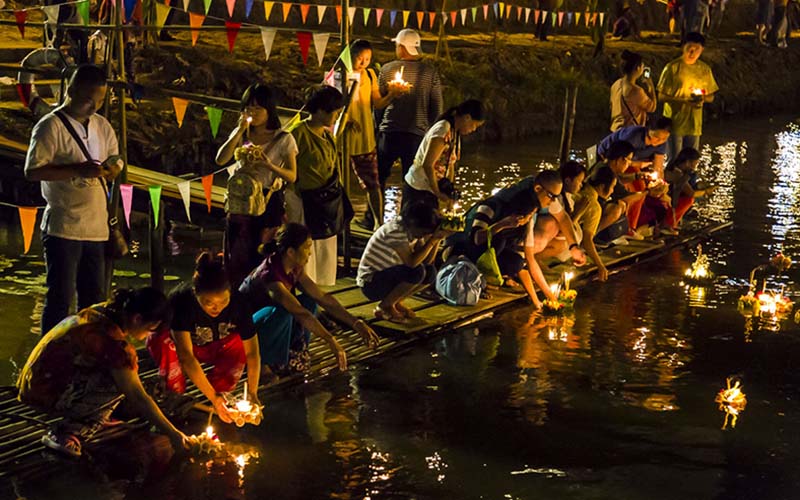
The Loy Krathong festival is celebrated on the 12th full moon night of the year, which usually falls after the monsoon during October-November. The word Loy refers to floating lanterns or lights. The word Krathong refers to the floating lanterns that are released into the water. Earlier, krathongs were made of a part of the banana tree trunk curated into a lotus shape by folding banana leaves to form a flower-like structure. The four components of a Krathong symbolize aspects of Buddhism: the candle represents light and knowledge, three incense sticks stands for purity and sympathy, and the flower shape represents the worship of the monks who are the disciples of Lord Buddha. The worshipping item is used as a benefit for departed ancestors. You can find these traditional krathongs in the nearby stalls during the festival or even buy the items separately and create your own beautiful Krathong. The modern-day krathongs may have a slight variation in shapes, from a turtle shape to shapes of other sea creatures. They are curated from coconut shells, flowers, baked bread, or potato slices. These are also available in the stalls during the main festival.
There are some strong beliefs regarding the release of these krathongs in the water.
- It releases negativity and a pessimistic attitude– It is believed in Buddhism that water cleanses the soul — so releasing krathongs in the water with a candle in the middle symbolizes letting go of evil deeds, anger, and sin, and moving with a fresh soul and a positive attitude in the upcoming year. Therefore, hair strands, nails, or even small pieces of old clothes are added to wipe out bad luck.
- It is a hope for good luck and a prosperous future– Thai people associate good or bad luck with the krathongs. It is considered to be a bad omen if your krathongs sink or do not float so it is advised to test the krathongs in the water. Also, couples whose krathongs remain together are believed to be lucky. It is the second Valentine’s Day for couples as they release their krathongs together and make a wish for a prosperous and happy future. Coins are added in the krathong as a meritorious token to attract good fate.
- It is a way to pay homage to the water goddess– The legend says that Nophamas wanted to honor the water goddess by floating the krathong. Therefore Thai people actively create krathongs and release them into the river to thank the water goddess for the generous rainfall during the monsoon and also apologize for polluting the water.
It is used to worship Lord Buddha- The old tales suggest that Nagas (the huge snake) gave Lord Buddha a token of appreciation before going to heaven. Lord Buddha left a footprint on the Nanmatha River in India which is worshipped by celebrating by a floating festival every year.
Places in Thailand where The Loy Krathong Festival Is Celebrated
1. Chiang Mai
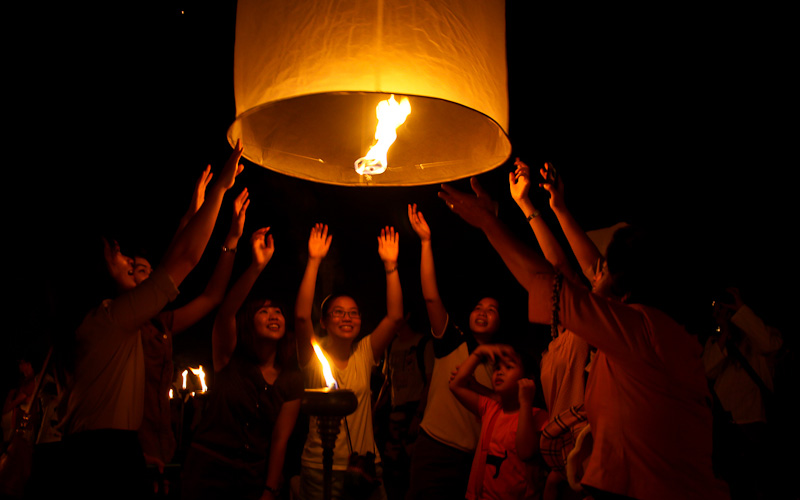
In Chiang Mai, the Loy Krathong festival compliments the Yi Peng festival which also falls almost on the same night. The legend of Yi Peng dates back to the time of the Lanna Kingdom. It is celebrated by releasing lanterns into the air. The lanterns are made of styrofoam and the candle is lit so that it becomes lighter and floats in the air. The krathongs are released into the water creating a charismatic scene, and drawing in people from around the globe. The festival is significant for Thai people as it involves letting go of negativity and wishing for a happy future.
2. Bangkok
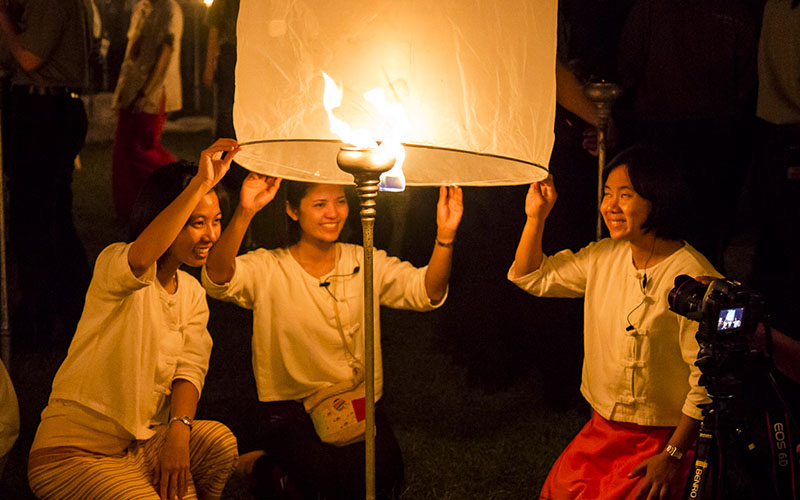
The Lantern Festival is celebrated in two different locations. One of them is the Asiatique market which hosts music shows and other events. Various stalls are set up where you can buy or prepare your own Krathong.
Another location is by the Chai Phraya River. Ferries carry the people across the river where people release their krathongs mid-stream. You can also pay homage to the different temples present on the banks of the river.
3. Sukothai
It is where this magnificent festival originated. Thus, it is celebrated with great pomp and show for over 5 days. Many events and competitions characterize these 5 days.
- Dry food served to Buddhist monks on the Greeting of the Dawn of Happiness.
- Wat Chana Songkhram’s famous Mahachat sermon
- Khon Marked traditional Thai music and dance performance
- A replication of the ancient Sukothai village and market
- Muay Thai boxing matches in Sukhothai Historical Park
- The floating of krathongs on Tra Kuan pond
Tips To Visit Thailand During The Loy Krathong Festival
- Book your hotel accommodations at least 3 months prior to the festival as during the festival time. It is very difficult to book a stay as it is the peak tourist season.
- Try to buy traditional krathongs made of banana leaves that are biodegradable and do not pollute the water.
- This festival is associated with the religious sentiments of Thai people, so ensure that you wear respectful clothing and avoid revealing clothes.
- In case the festival falls in the end of Novemeber, you will also find the excitement of Thailand New Year celebrations starting to surround the country.
Conclusion
Participating in the Loy Krathong Festival is a one-of-a-kind experience. For honeymooners, families, or friends, it is an opportunity to wish for the future and make unforgettable memories together. You can book a cruise tour to adore the beautifully lit-up surroundings. The best part is that even tourists can prepare their own krathongs and sail them in the water. If you are planning an exquisite vacation with your loved ones, then be sure to visit Thailand during November, this Loy Krathong Festival. Keep reading to discover more such festivals and public holidays in Thailand to plan your vacation well.
Frequently Asked Questions (FAQs)
1) What are the most significant customs observed during Loy Krathong?
Floating a krathong on a lake or river while saying prayers and making wishes is the primary ritual. As sacrifices to the water goddess, people frequently place a candle, incense sticks, and a little coin inside the krathong.
2) What does the Krathong Floating Festival represent?
Floating a krathong represents asking the water goddess for forgiveness for contaminating her resources and letting go of grudges, bad feelings, and bad luck.
3) Is Loy Krathong exclusively celebrated in Thailand?
While it is primarily a Thai festival, similar celebrations can be found in neighboring countries like Laos and Myanmar.
4) Is it possible for tourists to attend the Loy Krathong Festival?
Visitors are invited to take part in the festivities in many places. You can join the people in their ceremonies.
5) What is used to make krathongs?
Natural wood, flowers, and banana leaves are a few biodegradable materials used to make traditional krathongs. Bread, which dissolves in water and feeds fish, may be used in some contemporary renditions.
